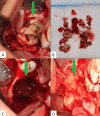A Giant Posterior Maxillary Intra-Sinusal Complex Odontoma: A Clinical Case
- PMID: 37637586
- PMCID: PMC10460139
- DOI: 10.7759/cureus.42546
A Giant Posterior Maxillary Intra-Sinusal Complex Odontoma: A Clinical Case
Abstract
Odontomas are the most common odontogenic neoplasms. They are generally small and asymptomatic. This article presents an unusual case of a giant maxillary complex odontoma, which obscured a part of the maxillary antrum and impacted a tooth. This was discovered during an episode of maxillofacial cellulitis. In this case, surgical excision of the lesion was performed under general anesthesia, and the closure was performed with a fat pad pedicled flap. A brief review of the literature was performed to analyze the characteristics of this clinical entity and their implication in the treatment.
Keywords: complex odontoma; computed tomography; impacted teeth; odontogenic tumors; oroantral communication.
Copyright © 2023, Kadri et al.
Conflict of interest statement
The authors have declared that no competing interests exist.
Figures



References
-
- World Health Organization 4th edition of head and neck tumor classification: insight into the consequential modifications. Slootweg PJ, El-Naggar AK. Virchows Arch. 2018;472:311–313. - PubMed
-
- Complex odontoma at the upper right maxilla: surgical management and histomorphological profile. Maltagliati A, Ugolini A, Crippa R, Farronato M, Paglia M, Blasi S, Angiero F. Eur J Paediatr Dent. 2020;21:199–202. - PubMed
-
- The epidemiology and management of odontomas: a European multicenter study [Online ahead of print] Boffano P, Cavarra F, Brucoli M, et al. Oral Maxillofac Surg. 2022 - PubMed
Publication types
LinkOut - more resources
Full Text Sources
